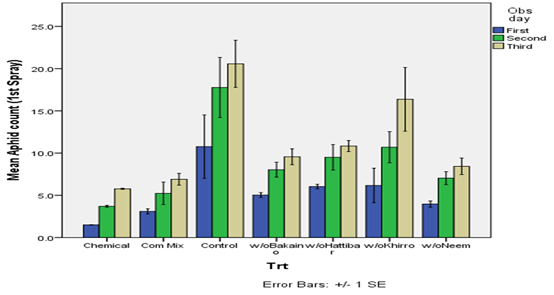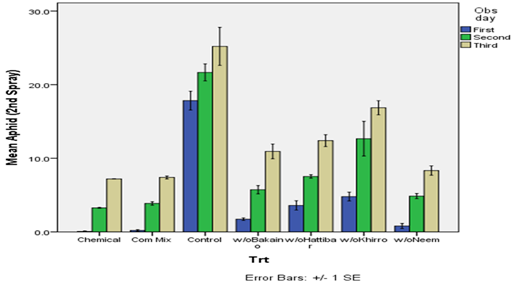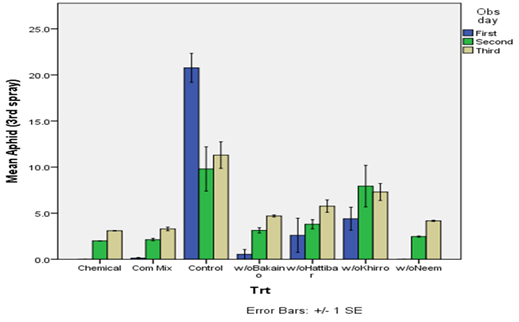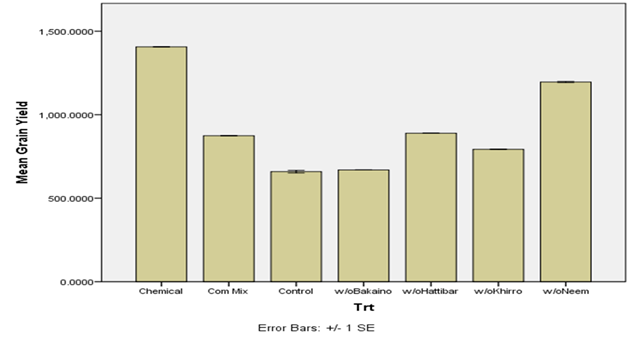Research Article
Volume 2 Issue 3 - 2018
Effectiveness of Plant Leaf Extract on Black Bean Aphid (Aphis Fabae Linn.)
Institute of Agriculture and Animal Science, Lamjung Campus
*Corresponding Author: B Subedi, Institute of Agriculture and Animal Science, Lamjung Campus, Nepal.
Received: November 13, 2017; Published: January 03, 2018
Abstract
Black bean aphid is devastating pest of faba bean (Vicia faba) causing great yield loss. Chemical pesticides were commonly used to control it but had residual effect, also have negative effect on others useful organisms as well as human health. So, this research aimed to find out less hazardous, environmentally safe and locally available botanicals effective for black bean aphid. The plant leaf extracts were prepared by decomposing chopped leaves of Neem, Bakaino “chinaberry”, Hattibar “centuryplant”, Khirro “milktrees”, Tobacco & Bojho “sweet flag”in cow urine for 1month period. Total five extracts were prepared, one by mixing all the leaf while remaining four extracts were prepared excluding one ingredient in each mixture but keeping Tobacco and Bojho “sweet flag”in all five extracts. Effect of different plant leaf extracts on black bean aphids in faba bean was accessed in field of Lamjung campus, Lamjung during November 2016 to April 2017. The experiment was carried out in RCBD consisting 7 treatments i.e. complete mixture (hattibar “centuryplant”, sweet flag, Khirro “milktrees”, neem, tobacco and bakaino “chinaberry”), mixture of without neem, without bakaino “chinaberry”, without Khirro “milktrees”, without hattibar “centuryplant”, chemical (cypermethrin10%EC) and control with3 replication in local variety of faba bean. Leaf extracts were sprayed at 30, 45 & 60DAS and Aphid numbers were recorded at 5, 10 and 15 days after each spray from 5cm apical twig. Result revealed that among various treatments used, chemical was found most effective on Black bean aphid followed by complete mixture in every spray. Highest number of aphid was found in control followed by without Khirro “milktrees”. Grain yield was obtained higher in chemical treatment plot but the second highest grain yield was found in treatment without neem which was found not that effective in aphid population reduction.
Keywords: Acorus calamus; Azadirachtin; Cypermethrin and Faba bean
Abbreviations: Cm: Centimeter; DAS: Days after Sowing; FYM: Farm Yard Manure; ha: hectare; i.e.: That is; IAAS: Institute of Agriculture and Animal Science; K: Potassium; Kg: Kilo gram; Lit: Liter; MOAD: Ministry of Agriculture Development; MT: Metric Ton; N: Nitrogen; no.: Numbers; Obs: Observation; P: Phosphorus; PP: Plant to Plant; RCBD: Randomized Complete Block Design; RR: Row to Row; Trt: Treatment; w/o: Without;
Introduction
Aphids are small, soft- pear shaped bodied insects with long slender mouthparts that they use to pierce stems, leaves, and other tender plant parts and suck out fluids. The black bean aphid (Aphis fabae) is a small black insect in the Aphis genus, a member of order Homoptera. It usually influences the host plant by removal of assimilates also honeydew excretion and growth of sooty moulds create an indirect damage through impeding some physiological process (Hurej, M. and W. van der werf, 1993). Black bean aphid accounts mostly for destructive pest attacking faba bean (Basedow, T.L. Hua and N. Aggarwal, 2009). Faba beans an annual legume botanically known as vicia faba L. (Hanelt and Mettin, 1989). It is one of among the oldest crop in the world (Singh., et al. 2013). It is a winter growing pulse or food legume crop, which is also known as broad bean and in Nepal it is known as ‘Bakulla’. The average national yield of faba bean as pulse is 1071 kg/ha and as fresh vegetable is 6.1 mt/ha (MOAD 2014).
Botanical insecticides are naturally occurring chemicals (insect toxins) extracted or derived from plants or minerals. 2400 types of plants with insecticidal properties are found in world. In Nepal such type of plant are 324 in number out of which 41 are known to be effective and in Nepal 23 are found (Neupane 2010). Chemical insecticides still remain as the key tool for the control of this pest. Farmers spray insecticides in their fields indiscriminately so, it causes phytotoxicity, destruction of beneficial organisms, disruption of agro-ecosystem, human health hazard and environmental pollution (McIntyre., et al. 1989). and many of them have become less effective due to development of resistance and pest resurgence, as well as the chemical pesticides are often of low quality and not amenable to control the insect pests despite of continuous use of pesticides, which induce resistance in pest populations (Dahal, 1995). Considering yield losses due to this pest, Botanical control measures are suggested as it is safer with locally available and in many cases seed yield loss have been minimized. The present investigation was carried out with the objective to study on the efficacy of some plant leaf extracts as insecticides against faba bean aphid (Aphis fabae), under field conditions at IAAS, Lamjung.
Materials and Methods
This research was conducted in farm of Institute of Agriculture and Animal Science in Sundarbazar, Lamjung, Nepal during November 2016 to April 2017. This experiment was laid out in Randomized Complete Block Design (RCBD) with 7 treatments and 3 replications. Individual plot size was 3m2 and Spacing: 40 cm (RR), 25 cm (PP). During field preparation recommended dose of FYM @12 ton\ha and fertilizer @40 kg\ha NPK each was applied following Dr. Kanhaiya Prasad Singh (2015). 3 seed per hill were sown and after proper germination 2 were thinned out. Intercultural operation were carried out as need except the fact that plants were allowed to be naturally infested and colonized by aphids.
Treatments
T1: All materials (khirro+sweet flag+tobacco+hattibar “centuryplant” + bakaino “chinaberry” + neem+3lit cow urine)
T2: Without Neem (khirro+hattibar “centuryplant” +sweet flag+tobacco+bakaino “chinaberry” +3lit cow urine)
T3: Without Bakaino “chinaberry” (khirro+hattibar “centuryplant” + sweetflag + tobacco + neem + 3lit cow urine)
T4: Without Hattibar “centuryplant” (khirro+neem+sweet flag+tobacco+bakaino “chinaberry” +3lit cow urine)
T5: Without Khirro (neem+hattibar “centuryplant” +sweet flag+tobacco+bakaino “chinaberry” +3lit cow urine)
T6: Cypermethrin and T7: control (water only)
T1: All materials (khirro+sweet flag+tobacco+hattibar “centuryplant” + bakaino “chinaberry” + neem+3lit cow urine)
T2: Without Neem (khirro+hattibar “centuryplant” +sweet flag+tobacco+bakaino “chinaberry” +3lit cow urine)
T3: Without Bakaino “chinaberry” (khirro+hattibar “centuryplant” + sweetflag + tobacco + neem + 3lit cow urine)
T4: Without Hattibar “centuryplant” (khirro+neem+sweet flag+tobacco+bakaino “chinaberry” +3lit cow urine)
T5: Without Khirro (neem+hattibar “centuryplant” +sweet flag+tobacco+bakaino “chinaberry” +3lit cow urine)
T6: Cypermethrin and T7: control (water only)
Preparation of plant leaf extracts
First neem (Azadirachta indica), bakaino “chinaberry” (Melia composite), hattibar “centuryplant” (Agave americana) and Khirro “milktrees” (Sapium insigne) @ 150 gm whereas tobacco (Nicotiana tabacum) and bojho “sweet flag” (Acorus calamus) @ 75 gm, were mixed with 3 lit.cow urine after leafs were cut into convenient size of 1-2 cm. These mixtures were kept in 5 drums of 5 lit capacity each and kept in warm place for 1 month. First week stir daily and once a week for 3 weeks. Then the mixture was filtrate with muslin clothes and mix with water at 1:4 ratio and cypermethrin 3 ml/1.5 lit of water. The prepared mixture was sprayed with help of hand sprayer at 15 days interval after 1 month of sowing for three times i.e. 30DAS, 45DAS and 60DAS. Three sample plants were taken from inner 3 rows of each plot leaving border rows (Das., et al. 2008). Aphids population were counted through eye estimation at 5, 10 and 15 days after each spray from 5 cm apical twig of sample plant (Sharma., et al. 2014). Final yield was also taken.
First neem (Azadirachta indica), bakaino “chinaberry” (Melia composite), hattibar “centuryplant” (Agave americana) and Khirro “milktrees” (Sapium insigne) @ 150 gm whereas tobacco (Nicotiana tabacum) and bojho “sweet flag” (Acorus calamus) @ 75 gm, were mixed with 3 lit.cow urine after leafs were cut into convenient size of 1-2 cm. These mixtures were kept in 5 drums of 5 lit capacity each and kept in warm place for 1 month. First week stir daily and once a week for 3 weeks. Then the mixture was filtrate with muslin clothes and mix with water at 1:4 ratio and cypermethrin 3 ml/1.5 lit of water. The prepared mixture was sprayed with help of hand sprayer at 15 days interval after 1 month of sowing for three times i.e. 30DAS, 45DAS and 60DAS. Three sample plants were taken from inner 3 rows of each plot leaving border rows (Das., et al. 2008). Aphids population were counted through eye estimation at 5, 10 and 15 days after each spray from 5 cm apical twig of sample plant (Sharma., et al. 2014). Final yield was also taken.
Result and Discussion
Mean aphids population at first spray (30 DAS)
Here in this graph we can observed highest mean aphid population was in control treatment and lowest was in chemical treatment followed by all mixture treatment Statically later two are at par. Here 1st, 2nd and 3rd observation indicated 5, 10 and 15 day aphid count. Aphids number were in increasing order as a result of increasing number of days after spray i.e decreasing in effectiveness longer duration.
Mean aphids population at 2nd spray (45 DAS)
In this graph also, highest mean aphid population was in control treatment and lowest in chemical treatment and chemical was followed by all mix treatment. Similar as 1st spray chemical and all mix treatment are statically at par.
Mean aphids population at 3rd spray (60DAS)
Highest and lowest mean aphid population was same as above. Here if compare between 1st, 2nd and 3rd spray we saw decreasing in mean aphid populations which is due to plant heading towards senescence.
Mean grain yield
This graph showed highest grain yield in treatment all mixture without neem after chemical treatment which are significantly different with each other. Similarly, lowest grain yield was in control treatment (Das., et al. 2008). This was followed by treatment without bakaino “chinaberry”. Neem has demonstrated activity as a nitrification inhibitor, helping to slow the bacterial activity that is responsible for denitrification, hence decreasing the loss of urea from the soil (Musalia., et al. 2000: Mohanty., et al. 2008. Treatment with neem extract or azadirachtin reduced the number of root nodules in the rhizosphere, when compared to control. (Sarawaneeyaruk., et al. 2015). That is why the yield of treatment mixture without neem has highest yield after chemical treatment.
Conclusion
For the alternative of chemical pesticides several plant leaves extract were used against black bean aphids. As a result we found that all plant leaf extract mixture was found to be most effective for controlling mean aphid population following check (chemical) treatment. Similarly treatment mixture without neem was found to give highest yield following check (chemical) treatment. Faba bean is one of the best crops among grain legumes with high yield potential and addition of atmospheric nitrogen to soil. This should be made acceptable to all.
References
- Hurej M and W van der werf. “The influence of black bean aphid, Aphis fabae Scop. And its honeydew on the photosynthesis of sugar beet”. Annals of Applied Biology122.2 (1993): 189-200.
- Basedow TL Hua and N Aggarwal. “The influence of Vicia faba L. (Fabaceae) by Aphis fabae (Scop). (Homoptera: Aphididae under the influence of lamiaceae (Ocimum basilicum L. and Satureja hortensis L.)”. Journal of Pest Science 79 (2009): 149-154.
- Bahar Md H., et al. “Effectiveness of Botanical Extracts on Bean Aphids Attacking Yard- long Beans”. Journal of Entomology 4 (2007): 136-142.
- Neupane FP. “Crop pest and their management, 5th Ed. Sajha prakashan, lalitpur, Nepal”. (2010):
- Singh KP and RR Bhandari. “Vegetable crops production techniques”. (2015): 171-174.
- Singh AK., et al.“An assessment of faba bean current status and future prospect”. African journal of Agriculture research8.50 (2013): 6634-6641.
- Sharma SK., et al. “Management of aphid pests by using organic inputs in organically grown crops”. International Journal of Agricultural Sciences and Veterinary Medicine 2.1 (2014): 2320-3730.
- Das BC., et al.“Aphidicidal activity of some indigenous plant extracts against bean aphid Aphis craccivora Koch (Homoptera: Aphididae)”. Journal of Pest Science 81.3 (2008): 153-159.
- Mohanty S., et al. “Neem (Azadirachta indica) seed kernel powder retards urease and nitrification activities in different soils at contrasting moisture and temperature regimes”. Bioresource Technology99.4 (2008): 894-899.
- Musalia L., et al.“Urea-treated neem (Azadirachta indica A. juss) seed kernel cake as a protein supplement for lambs”. Small Ruminant Research35.2 (2000): 107-116.
- Matthews P and TH Marcellos. “Faba bean”. (2003):
Citation:
B Subedi., et al. “Effectiveness of Plant Leaf Extract on Black Bean Aphid (Aphis Fabae Linn.)” Innovative Techniques in Agriculture
2.3 (2018): 395-399.
Copyright: © 2018 B Subedi., et al. This is an open-access article distributed under the terms of the Creative Commons Attribution License, which permits unrestricted use, distribution, and reproduction in any medium, provided the original author and source are credited.

































 Scientia Ricerca is licensed and content of this site is available under a Creative Commons Attribution 4.0 International License.
Scientia Ricerca is licensed and content of this site is available under a Creative Commons Attribution 4.0 International License.